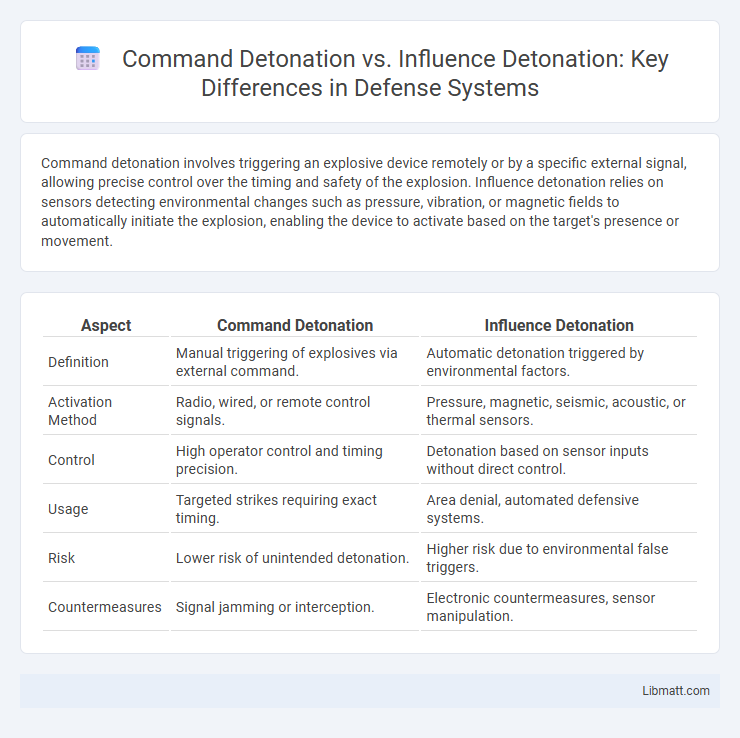Command detonation involves triggering an explosive device remotely or by a specific external signal, allowing precise control over the timing and safety of the explosion. Influence detonation relies on sensors detecting environmental changes such as pressure, vibration, or magnetic fields to automatically initiate the explosion, enabling the device to activate based on the target's presence or movement.
Table of Comparison
| Aspect | Command Detonation | Influence Detonation |
|---|---|---|
| Definition | Manual triggering of explosives via external command. | Automatic detonation triggered by environmental factors. |
| Activation Method | Radio, wired, or remote control signals. | Pressure, magnetic, seismic, acoustic, or thermal sensors. |
| Control | High operator control and timing precision. | Detonation based on sensor inputs without direct control. |
| Usage | Targeted strikes requiring exact timing. | Area denial, automated defensive systems. |
| Risk | Lower risk of unintended detonation. | Higher risk due to environmental false triggers. |
| Countermeasures | Signal jamming or interception. | Electronic countermeasures, sensor manipulation. |
Introduction to Detonation Mechanisms
Command detonation involves initiating an explosive charge through a direct external signal, providing precise timing control. Influence detonation occurs when an explosive responds to environmental stimuli such as pressure, magnetic fields, or seismic vibrations, enabling activation without direct physical contact. Understanding these mechanisms is crucial for applications in military ordnance, mining, and controlled demolitions where timing and activation methods impact safety and effectiveness.
Defining Command Detonation
Command detonation is a controlled explosive initiation where a signal or command triggers the detonation at a precise moment, ensuring targeted timing and safety. This method contrasts with influence detonation, which relies on environmental factors like pressure, magnetic fields, or vibration to activate the explosive. Command detonation is commonly used in military applications to allow for remote control and strategic deployment of munitions.
Defining Influence Detonation
Influence detonation is a type of explosive initiation triggered by external factors such as magnetic fields, pressure, or acoustic signals, rather than direct physical contact or command signals. It relies on sensors embedded within mines or bombs that detect changes in the environment, causing the device to detonate when specific influence parameters are met. This method enhances tactical effectiveness by enabling remote, automated activation based on the presence or proximity of a target.
Key Differences Between Command and Influence Detonation
Command detonation involves manually triggering an explosive device through a direct signal or command, allowing precise timing controlled by the operator. Influence detonation relies on sensors detecting changes in the environment--such as pressure, magnetic fields, or seismic activity--to automatically initiate the explosion when specific conditions are met. Your choice between command and influence detonation depends on desired control, target detection methods, and situational requirements for activation accuracy.
Typical Applications of Command Detonation
Command detonation is widely applied in military operations for controlled explosions, such as breaching obstacles, demolishing structures, and neutralizing unexploded ordnance with precise timing. This method allows operators to detonate charges remotely, ensuring safety and tactical advantage during demolition or combat engineering tasks. Command detonation is essential in bomb disposal units, combat engineering, and tactical demolition where immediate human control over explosion timing is critical.
Common Uses of Influence Detonation
Influence detonation is commonly used in military applications for triggering mines or explosives based on changes in environmental factors such as magnetic fields, pressure, or acoustic signatures. This method allows precise activation of devices when a target is detected nearby, enhancing safety and target specificity. Your operations can benefit from influence detonation by minimizing accidental triggers and improving operational effectiveness in complex combat scenarios.
Advantages of Command Detonation Systems
Command detonation systems offer precise control over the exact timing of an explosion, significantly reducing the risk of premature or delayed detonation compared to influence detonation methods. These systems enhance safety by allowing you to manually trigger the device when the target is confirmed, minimizing accidental detonations caused by environmental factors or false signals. Their reliability and accuracy make them ideal for operations requiring controlled and coordinated explosions in complex or high-risk environments.
Benefits and Risks of Influence Detonation Systems
Influence detonation systems offer precise targeting by detecting physical, magnetic, or acoustic signatures, enhancing your ability to neutralize threats with minimal collateral damage. Their benefits include increased effectiveness against diverse targets and adaptability to changing environments, but they carry risks such as susceptibility to countermeasures and accidental detonations caused by non-hostile triggers. Careful calibration and advanced sensor technology are essential to maximize safety and operational reliability.
Countermeasures Against Command and Influence Detonation
Countermeasures against command detonation emphasize signal jamming, encryption, and electronic warfare techniques to prevent detonation commands from reaching the explosives. Influence detonation countermeasures focus on altering or masking environmental triggers such as magnetic fields, seismic vibrations, or pressure changes to avoid activation. Your operational safety improves by integrating these countermeasures to disrupt both remote activation signals and sensor-based triggers effectively.
Future Developments in Detonation Technology
Future developments in detonation technology are expected to enhance precision and control in both command detonation and influence detonation systems, leveraging advancements in sensor fusion and artificial intelligence to optimize timing and trigger conditions. Innovations in miniaturized electronics and improved materials are set to increase the reliability and adaptability of command detonation devices, while influence detonation mechanisms will benefit from more sophisticated target discrimination capabilities and environmental adaptability. These improvements aim to maximize effectiveness while minimizing unintended collateral damage, supporting more strategic and flexible applications in defense and demolition.
command detonation vs influence detonation Infographic

 libmatt.com
libmatt.com